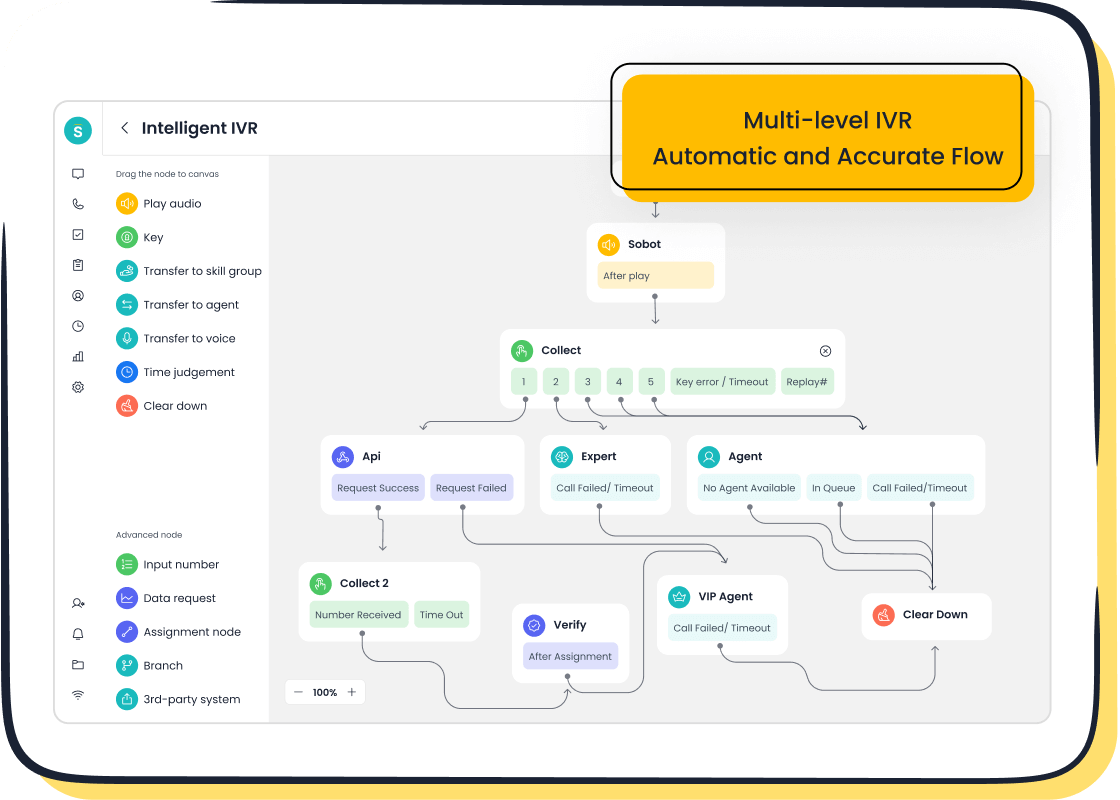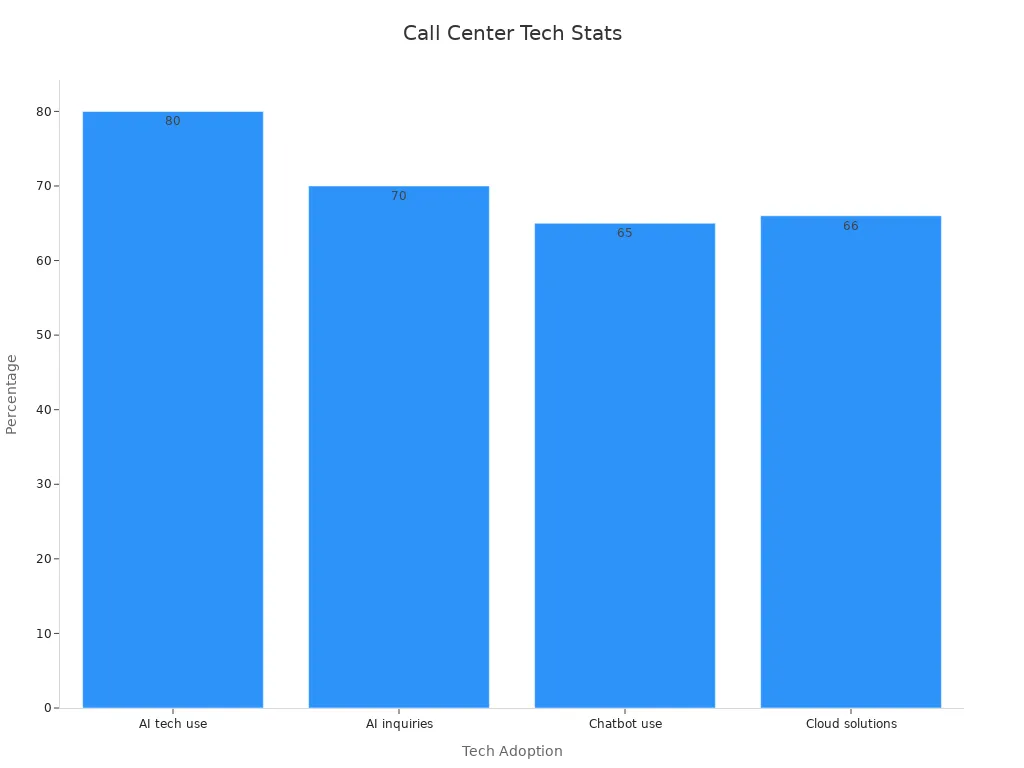Optimizing E-commerce Customer Service with Call Centers

E-commerce businesses rely on call centers to deliver great customer experience. In 2025, the demand for efficient ecommerce customer service continues to grow. Customers expect quick resolutions and personalized interactions. Optimizing your ecommerce customer service call center boosts satisfaction rates and increases operational efficiency. Advanced tools, like Sobot’s solutions, help you meet these expectations. They streamline service processes and improve profitability, ensuring your business stays competitive in the evolving e-commerce landscape.
The Role of E-commerce Customer Service Call Centers

Inbound vs. Outbound Call Centers in E-commerce
Inbound call centers focus on handling incoming calls from customers. These calls often involve inquiries, complaints, or requests for assistance. In e-commerce, inbound call centers play a critical role in resolving issues quickly and ensuring customer satisfaction. They reduce complaints and enhance the overall customer experience by offering personalized service and proactive problem-solving.
Outbound call centers, on the other hand, initiate calls to customers. These calls aim to build relationships, generate leads, or follow up on previous interactions. Outbound call centers in e-commerce help strengthen customer loyalty by maintaining consistent communication. They also identify potential leads, nurturing them for business growth.
| Aspect | Inbound Call Centers | Outbound Call Centers |
|---|---|---|
| Customer Satisfaction | Reduces complaints and enhances satisfaction through proactive problem-solving and personalized service. | Enhances customer loyalty through regular follow-up calls. |
| Efficiency | High efficiency in handling a large volume of calls with real-time monitoring and scalability. | Focuses on lead generation and customer engagement. |
| Personalization | Provides tailored responses to customer needs, improving overall experience. | Identifies and nurtures potential leads for business growth. |
Key Functions of E-commerce Call Centers
E-commerce call centers serve as the backbone of customer support operations. They handle inquiries, resolve complaints, and provide assistance with orders and returns. These call centers also track performance metrics to ensure service quality and operational efficiency.
Some key functions include:
- Customer experience metrics: Assess how easily customers can get help and their satisfaction levels.
- Agent performance metrics: Evaluate how efficiently agents handle calls and resolve issues.
- Call center performance metrics: Measure overall service quality and operational effectiveness.
According to PwC, 72% of customers consider customer experience a key factor in their purchasing decisions. Forrester reports that customer-focused companies saw a 10% increase in earnings last year. These statistics highlight the importance of optimizing call center operations to meet customer expectations.
Personalization and Its Impact on Customer Satisfaction
Personalization transforms customer interactions into meaningful experiences. By tailoring responses to individual needs, e-commerce call centers can significantly improve customer satisfaction. AI-driven tools like chatbots and virtual assistants enhance this process by providing quick and accurate solutions.
| Evidence Type | Description |
|---|---|
| AI-driven Recommendations | Personalized recommendations enhance the shopping experience by tailoring it to individual customer needs, leading to increased satisfaction. |
| Chatbots and Virtual Assistants | The use of AI in customer service, particularly through chatbots, improves the handling of complaints and inquiries, ensuring customer satisfaction. |
| Management Implications | E-commerce organizations can leverage AI tools to improve customer relationship strategies, meeting and exceeding customer expectations. |
Personalized service builds trust and loyalty, ensuring customers return for future purchases. It also reduces complaints and increases the likelihood of positive reviews, which are crucial for e-commerce success.
Challenges in E-commerce Call Centers
Managing Seasonal Spikes in E-commerce Demand
Seasonal demand spikes can overwhelm your call center operations. Holidays, sales events, and promotions often lead to a surge in customer inquiries. Without proper planning, your team may struggle to handle the increased call volume, leading to delays and reduced customer satisfaction.
Forecasting tools can help you prepare for these spikes. Multivariate regression analysis predicts call volumes by assessing seasonal trends and other factors. Time series analysis uses historical data to identify patterns, enabling you to anticipate future demand. These methods allow you to allocate resources effectively, ensuring your customers receive timely service during peak periods.
Tip: Use AI-driven analytics to monitor call trends and adjust staffing levels in real time. This ensures your team stays efficient even during high-demand seasons.
Addressing High Return and Refund Rates
Returns and refunds are common in e-commerce. Customers often call to inquire about policies, track refunds, or resolve issues with returned items. High return rates can strain your call center, especially if processes are inefficient.
Streamlining your return and refund workflows reduces the burden on your agents. Automated systems can handle repetitive tasks like refund tracking, freeing your team to focus on complex customer concerns. Clear communication about policies also minimizes confusion, improving the overall customer experience.
Note: A well-organized return process not only reduces call center workload but also boosts customer satisfaction by resolving issues quickly.
Balancing Infrastructure Costs with Scalability
Scaling your call center to meet growing demands requires careful financial planning. Infrastructure costs, recruitment, and training can add up quickly. However, cloud-based solutions offer a cost-effective way to scale operations without compromising service quality.
| Category | Cost Range |
|---|---|
| Initial Infrastructure Setup | $20,000 - $50,000 |
| Licensing Fees for AI-Driven Analytics Tools | $5,000 - $15,000 |
| Recruitment and Training of Agents | $1,000 - $3,000 per agent |
| Marketing and Promotional Expenses | 10% - 20% of operational costs |
| Cost Reduction via Cloud Solutions | Up to 30% savings |
| Staffing Cost Reduction (Part-Time Agents) | 20% - 40% savings |
Cloud solutions reduce costs by up to 30%, while part-time staffing can save an additional 20% to 40%. These strategies help you maintain scalability without overspending. By investing in flexible systems, you ensure your call center adapts to changing demands while delivering excellent service to your customers.
Strategies to Optimize E-commerce Call Centers
Training and Upskilling Call Center Agents
Well-trained agents form the backbone of any successful e-commerce call center. By investing in their training, you can significantly improve service quality and customer satisfaction. Training programs should focus on enhancing communication skills, product knowledge, and problem-solving abilities. Upskilling agents with advanced tools and technologies ensures they stay ahead in a competitive market.
Regular feedback sessions play a crucial role in fostering a culture of continuous improvement. These sessions help agents identify areas for growth and align their performance with organizational goals. Establishing clear benchmarks also provides a roadmap for agents to achieve higher efficiency and deliver exceptional service.
| Metric | Target Range | Impact on Business |
|---|---|---|
| First Call Resolution (FCR) | 80-90% | Fewer repeat calls, happier customers |
| Average Handle Time (AHT) | < 5 minutes | Better efficiency, lower costs |
| Customer Satisfaction (CSAT) | 4.5-5.0 out of 5 | More loyal customers, better reputation |
| Agent Retention Rate | > 85% | Lower hiring costs, stable teams |
These metrics highlight the importance of agent training in achieving operational excellence. When agents feel supported and empowered, they perform better, leading to improved customer experiences.

Tip: Use advanced tools like Sobot's Voice Call Center to monitor agent performance and provide real-time feedback. This ensures continuous improvement and better service delivery.
Leveraging AI and Automation for E-commerce Efficiency
AI and automation have revolutionized e-commerce customer service. They streamline operations, reduce costs, and enhance customer interactions. AI-powered tools like chatbots handle repetitive tasks, allowing agents to focus on complex issues. Real-time assistance provided by AI helps agents access relevant information quickly, boosting productivity.
| Statistic | Description |
|---|---|
| 80% | of call centers use AI-based technologies to enhance customer interactions. |
| 70% | of customer inquiries are predicted to be handled by AI without human intervention by the end of 2024. |
| 65% | of call centers have implemented chatbots for basic customer service functions. |
| 66% | of call centers use cloud-based solutions, enhancing scalability and remote work capabilities. |

AI tools also improve operational efficiency by automating quality assurance processes. For example, Sobot's AI-powered Voicebot uses intelligent interaction and intent recognition to resolve customer queries faster. This reduces average handle time and increases first-contact resolution rates, ensuring a seamless customer experience.
Note: By adopting AI and automation, you can enhance productivity and deliver personalized service, meeting the growing demands of e-commerce.

Implementing Omnichannel Support with Sobot Solutions
Omnichannel support ensures customers receive consistent service across all communication channels. Sobot's Omnichannel Solution integrates voice, email, social media, and chat into a unified platform. This seamless integration enhances customer management and improves response quality.
| Metric | Result |
|---|---|
| Increase in agent efficiency | 30% |
| Customer Satisfaction (CSAT) | 97% |
With Sobot's solution, agents gain immediate access to comprehensive customer information. This enables them to provide personalized and efficient service, boosting customer satisfaction. The platform also includes AI-driven chatbots that handle repetitive queries, freeing agents to focus on more complex issues.
Example: Weee!, an online Asian supermarket, implemented Sobot's voice product to address challenges like language barriers and time zone differences. The result? A 20% increase in agent efficiency and a 50% reduction in resolution time. Their customer satisfaction score soared to 96%.
By adopting omnichannel support, you can streamline operations and deliver a superior customer experience. Sobot's solutions empower your team to meet customer expectations and drive business growth.
Tracking Performance Metrics and KPIs for Continuous Improvement
Tracking performance metrics and key performance indicators (KPIs) is essential for improving your e-commerce call center. These metrics help you measure success, identify areas for improvement, and ensure your team delivers excellent customer service. By focusing on the right KPIs, you can enhance efficiency and meet customer expectations.
Key Metrics to Monitor
Monitoring specific metrics allows you to evaluate the performance of your call center. Each metric provides valuable insights into different aspects of your operations. Here are some of the most important ones:
| Metric | Description | Industries Covered |
|---|---|---|
| First Call Resolution (FCR) | Rate at which calls are resolved on the first contact. | All industries |
| Average Handle Time (AHT) | Average duration of a call, including hold time and talk time. | All industries |
| Customer Satisfaction (CSAT) | Score reflecting customer satisfaction with the service received. | All industries |
| Transfer Rate | Percentage of calls transferred to another agent or department. | Finance |
| Net Promoter Score | Metric indicating customer likelihood to recommend the service. | Finance, Healthcare |
| Peak Hour Traffic | Time of day with the highest call volume. | Education |
| Schedule Adherence | Measure of how closely agents follow their scheduled shifts. | Education, Non-profit |
| Cost Per Contact | Average cost incurred for each customer service call. | Non-profit |
These metrics provide a clear picture of your call center's performance. For example, a high First Call Resolution (FCR) rate shows that your team resolves issues quickly, which improves customer satisfaction. Monitoring Average Handle Time (AHT) helps you identify inefficiencies and reduce costs.
Benefits of Tracking KPIs
Tracking KPIs benefits your e-commerce customer service in several ways. It helps you identify trends, improve agent performance, and enhance the customer experience. For instance:
- Improved Efficiency: Metrics like AHT and Schedule Adherence help you optimize workflows and ensure agents stay productive.
- Better Customer Satisfaction: Monitoring CSAT and Net Promoter Score allows you to understand how customers feel about your service and make necessary adjustments.
- Cost Management: Keeping an eye on Cost Per Contact helps you manage expenses while maintaining high-quality service.

Tip: Use tools like Sobot's Voice Call Center to track these metrics in real time. This ensures you can make data-driven decisions and continuously improve your operations.
How to Use Metrics for Continuous Improvement
To achieve continuous improvement, you need to act on the insights provided by your metrics. Here’s how you can do it:
- Set Clear Goals: Define what success looks like for each metric. For example, aim for an FCR rate of 80% or higher.
- Analyze Data Regularly: Review your metrics weekly or monthly to identify patterns and areas for improvement.
- Provide Feedback to Agents: Share performance data with your team and offer actionable feedback. This helps agents understand their strengths and areas for growth.
- Invest in Training: Use insights from metrics like Transfer Rate to identify skill gaps and provide targeted training.
- Leverage Technology: Tools like Sobot's AI-powered Voicebot can help you automate repetitive tasks, reducing AHT and improving FCR.
By following these steps, you can create a culture of continuous improvement in your call center. This not only enhances your service quality but also boosts customer loyalty and business growth.
Note: Consistently tracking and acting on KPIs ensures your e-commerce call center stays competitive in a rapidly evolving market.
Tools and Software to Enhance E-commerce Call Center Operations

Sobot Voice/Call Center: Features and Benefits
A robust call center solution like Sobot Voice/Call Center can transform your e-commerce customer service. This tool offers features designed to improve efficiency and enhance customer satisfaction.
| Feature/Benefit | Description |
|---|---|
| Real-time Customer Support | Handle inquiries about product information, pricing, and availability instantly. |
| Automation of Routine Inquiries | Reduce the workload on your team by automating common questions. |
| Improved Response Times | Address customer inquiries faster, leading to better satisfaction. |
Sobot Voice/Call Center reduces response times by up to three hours, allowing your team to focus on strategic growth initiatives. Businesses using this solution have reported a 25% increase in customer satisfaction ratings. For example, a company struggling with manual inquiries integrated Sobot's chatbot and WhatsApp Business API. This automation significantly improved response times and customer satisfaction.
By streamlining inbound call routing, Sobot's solution enhances efficiency and reduces unnecessary transfers. This ensures customers connect with the right agent quickly, improving their overall experience.

Tip: Use Sobot's AI-powered Voicebot to automate repetitive tasks and provide intelligent interaction, saving time for both agents and customers.
CRM Integrations for Streamlined Customer Data
Integrating your call center with a CRM system simplifies customer data management. This integration provides agents with instant access to customer information, enabling personalized and efficient service.
| KPI | Description | Improvement from Integration |
|---|---|---|
| Customer Satisfaction | Fast, convenient, and personalized service through CRM data. | Reduces customer effort and increases satisfaction by routing them to the best resource for resolution. |
| Agent Productivity | Access to information and tools at agents' fingertips. | Reduces time spent navigating between applications, increasing time spent serving customers. |
| Average Handle Time | Shortened call length by identifying customers before interactions. | Enables quicker routing and resolution, saving time for both agents and customers. |
| Wait Time | Reduced wait times for customers due to shorter Average Handle Time. | Example: Swisslog Healthcare reduced wait times by 30% after implementing CRM integration. |
| First Call Resolution Rate | Increased ability to resolve interactions in a single call. | Reduces follow-up calls and transfers by connecting customers to the most qualified agent immediately. |
CRM integrations also improve agent productivity by reducing the time spent switching between applications. This allows agents to focus on delivering exceptional service. For instance, Swisslog Healthcare reduced customer wait times by 30% after implementing CRM integration.
Note: Combining Sobot's Voice/Call Center with a CRM system ensures seamless data sharing, improving both efficiency and customer satisfaction.
AI-Powered Chatbots and Virtual Assistants
AI-powered chatbots have become essential for modern e-commerce call centers. These tools handle repetitive tasks, gather customer feedback, and provide personalized recommendations.
- Generative AI chatbots initiate conversations to collect feedback.
- They administer short surveys to measure satisfaction.
- The data collected generates actionable analytics for service improvement.
Brands using 24/7 chatbot support have seen a 30% increase in user retention. Additionally, a 10% rise in user engagement can lead to a 21% revenue boost. Modern AI chatbots learn from past interactions, offering tailored recommendations that enhance customer loyalty.
Sobot's AI-powered chatbot provides multilingual support and integrates seamlessly with other platforms. This ensures your customers receive consistent service across all channels. By automating routine inquiries, Sobot's chatbot frees up your agents to focus on complex issues, improving overall efficiency.
Example: A financial institution using AI-powered conversation intelligence improved call routing in real-time. This enhanced customer experience and increased conversion opportunities.
Cloud-Based Call Center Solutions for Scalability
Cloud-based call center solutions offer a powerful way to scale your e-commerce customer service operations. These solutions adapt to changing demands, ensuring your team can handle fluctuating call volumes efficiently. By leveraging cloud technology, you gain flexibility, cost savings, and enhanced collaboration.
Why Cloud-Based Solutions Are Ideal for Scalability
Cloud-based systems allow you to scale operations up or down based on your needs. During peak seasons, you can quickly add more agents without investing in expensive hardware. When demand decreases, you can scale back to minimize costs. This flexibility ensures your call center remains efficient year-round.
Tip: Use cloud solutions to respond to sudden increases in customer inquiries during holidays or sales events. This ensures customers receive timely support without delays.
Key Benefits of Cloud-Based Call Centers
Cloud-based solutions provide several advantages that enhance scalability and efficiency. Here’s how they help your e-commerce business:
- Quickly scale up or down based on support needs.
- Easily add more agents during peak times without significant infrastructure investments.
- Adapt to changing customer expectations and market conditions.
These benefits ensure your call center can meet customer demands while maintaining high service quality.
Scalability Metrics That Drive Success
Cloud-based call centers deliver measurable improvements in scalability. The following table highlights key metrics that demonstrate their advantages:
| Benefit | Description |
|---|---|
| Increased Flexibility | Cloud solutions allow businesses to scale operations up or down based on demand. |
| Cost Efficiency | Eliminates the need for costly hardware and maintenance, allowing payment only for needed resources. |
| Enhanced Collaboration | Centralizes customer interactions and data, enabling agents to provide personalized support. |
These metrics show how cloud solutions optimize your operations, reduce costs, and improve customer service.
How Cloud Solutions Enhance Collaboration
Cloud-based platforms centralize customer interactions and data, enabling agents to provide personalized support. With instant access to customer information, your team can resolve issues faster and deliver a seamless experience. This collaboration improves efficiency and ensures customers feel valued.
Note: Centralized systems reduce the time agents spend searching for information, allowing them to focus on delivering exceptional service.
Steps to Implement Cloud-Based Scalability
- Assess your current call center infrastructure and identify areas for improvement.
- Choose a cloud-based solution that aligns with your business needs.
- Train your agents to use the platform effectively.
- Monitor performance metrics to ensure scalability meets customer expectations.
- Continuously optimize your system based on data insights.
By following these steps, you can create a scalable call center that adapts to your e-commerce business's growth.
Example: A retail company implemented a cloud-based call center during a holiday sale. They scaled operations to handle a 40% increase in call volume, ensuring customers received timely support. After the sale, they scaled back to reduce costs, maintaining efficiency without overspending.
Cloud-based call center solutions empower your team to deliver exceptional service while staying agile in a competitive market. By adopting these systems, you ensure your e-commerce business remains prepared for any challenge.
Examples of Successful E-commerce Call Center Implementations
Case Study: Weee! and Sobot Voice/Call Center

Weee!, the largest online Asian supermarket in America, faced challenges in managing its customer service operations. Issues like inflexible IVR systems, language barriers, and time zone differences created inefficiencies. By implementing Sobot's Voice/Call Center solution, Weee! transformed its operations. The flexible IVR system enabled intelligent call routing, ensuring customers connected with the right agents. The integrated workbench streamlined communication across channels, improving agent efficiency by 20%. Multilingual support and time zone settings allowed agents to serve customers more effectively.
The results were remarkable. Resolution times dropped by 50%, and the customer satisfaction score soared to 96%. This case demonstrates how Sobot's solutions can address complex challenges and deliver measurable improvements in customer service.
Lessons Learned from Industry Leaders in E-commerce
Industry leaders have shown that optimizing call centers can significantly enhance customer satisfaction. For example, a Washington-based e-commerce giant improved its shopping experience by managing its product catalog efficiently. This optimization created seamless customer journeys, boosting satisfaction. Similarly, a private equity firm specializing in Amazon brands achieved daily metrics for handling inquiries and returns within 90 days of onboarding. This rapid improvement highlighted the importance of setting clear goals and leveraging advanced tools.
These examples emphasize the value of efficient workflows, data-driven decisions, and customer-centric strategies. By adopting these practices, you can elevate your service quality and build lasting customer relationships.
How Sobot Drives Efficiency and Customer Satisfaction
Sobot's solutions empower you to optimize your e-commerce call center. The Voice/Call Center offers features like intelligent IVR, smart call routing, and AI-powered Voicebots. These tools reduce average handle time and improve first-contact resolution rates. The Omnichannel Solution integrates voice, email, and chat into a unified platform, ensuring consistent service across channels.
For instance, Sobot's AI-driven chatbots handle repetitive queries, freeing agents to focus on complex issues. This automation enhances efficiency and allows your team to deliver personalized service. Businesses using Sobot's solutions have reported up to a 30% increase in agent productivity and a 25% boost in customer satisfaction. By leveraging Sobot's technology, you can meet customer expectations and drive business growth.
Optimizing your e-commerce call center is essential for delivering exceptional customer service. It improves satisfaction, streamlines operations, and drives business growth.
Key Takeaways:
- Strategies: Train agents, adopt AI tools, and implement omnichannel solutions.
- Tools: Use Sobot’s Voice/Call Center and CRM integrations for efficiency.
- Examples: Learn from Weee!’s success with Sobot’s solutions.
Start applying these practices today. They help you meet customer expectations and build lasting loyalty.
FAQ
What is the best way to handle high call volumes during peak seasons?
You can use AI-driven analytics to predict call volumes and adjust staffing levels. Cloud-based solutions also allow you to scale operations quickly. These tools ensure your team handles increased demand efficiently, maintaining customer satisfaction.
How does Sobot’s Voice/Call Center improve agent productivity?
Sobot’s Voice/Call Center provides features like intelligent IVR, smart call routing, and a unified workspace. These tools reduce average handle time and automate repetitive tasks. Agents can focus on complex issues, improving productivity by up to 30%.
Can I integrate Sobot’s solutions with my existing CRM system?
Yes, Sobot’s solutions integrate seamlessly with most CRM systems. This integration provides agents with instant access to customer data, enabling personalized service. It also reduces the time spent switching between applications, improving efficiency.
What are the benefits of using AI-powered chatbots in e-commerce?
AI-powered chatbots handle repetitive queries, provide 24/7 support, and offer personalized recommendations. They reduce agent workload and improve response times. Businesses using chatbots report higher customer satisfaction and retention rates.
How do omnichannel solutions enhance customer service?
Omnichannel solutions unify communication channels like voice, email, and chat. This integration ensures consistent service across platforms. Agents access customer data in one place, enabling faster and more personalized responses.
See Also
Comprehensive Overview of Omnichannel Call Center Solutions
Enhancing Sales Through Ecommerce Live Chat Tools
Increasing Customer Satisfaction with E-commerce Chatbots
Essential Features to Look for in CRM Call Centers
Improving Call Center Efficiency Through Effective Monitoring
